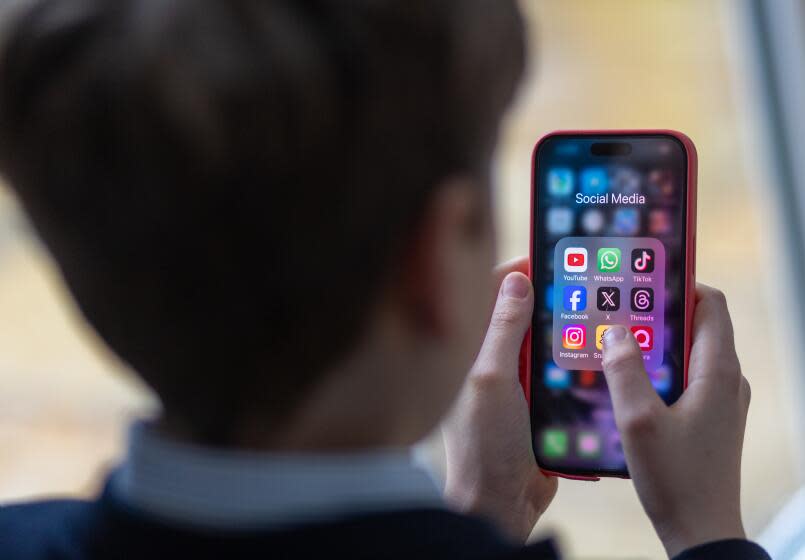Opinion: Does social media rewire kids' brains? Here's what the science really says

America’s young people face a mental health crisis, and adults constantly debate how much to blame phones and social media. A new round of conversation has been spurred by Jonathan Haidt’s book “The Anxious Generation,” which contends that rising mental health issues in children and adolescents are the result of social media replacing key experiences during formative years of brain development.
The book has been criticized by academics, and rightfully so. Haidt’s argument is based largely on research showing that adolescent mental health has declined since 2010, coinciding roughly with mass adoption of the smartphone. But of course, correlation is not causation. The research we have to date suggests that the effects of phones and social media on adolescent mental health are probably much more nuanced.
Read more: Opinion: Troubled youth? Contrary to stereotypes, much of Gen Z is doing just fine
That complex picture is less likely to get attention than Haidt’s claims because it doesn’t play as much into parental fears. After all, seeing kids absorbed in their phones, and hearing that their brains are being “rewired,” calls to mind an alien world-domination plot straight from a sci-fi film.
And that’s part of the problem with the “rewiring the brain” narrative of screen time. It reflects a larger trope in public discussion that wields brain science as a scare tactic without yielding much real insight.
First, let’s consider what the research has shown so far. Meta-analyses of the links between mental health and social media give inconclusive or relatively minor results. The largest U.S. study on childhood brain development to date did not find significant relationships between the development of brain function and digital media use. This month, an American Psychological Assn. health advisory reported that the current state of research shows “using social media is not inherently beneficial or harmful to young people” and that its effects depend on “pre-existing strengths or vulnerabilities, and the contexts in which they grow up.”
Read more: Editorial: Social media companies refuse to safeguard kids. It's up to lawmakers now
So why the insistence from Haidt and others that smartphones dangerously rewire the brain? It stems from misunderstandings of research that I have encountered frequently as a neuroscientist studying emotional development, behavioral addictions and people’s reactions to media.
Imaging studies in neuroscience typically compare some feature of the brain between two groups: one that does not do a specific behavior (or does it less frequently) and one that does the behavior more frequently. When we find a relationship, all it means is either that the behavior influences something about the functioning of this brain feature, or something about this feature influences whether we engage in the behavior.
In other words, an association between increased brain activity and using social media could mean that social media activates the identified pathways, or people who already have increased activity in those pathways tend to be drawn to social media, or both.
Fearmongering happens when the mere association between an activity such as social media use and a brain pathway is taken as a sign of something harmful on its own. Functional and structural research on the brain cannot give enough information to objectively identify increases or decreases in neural activity, or in a brain region’s thickness, as “good” or “bad.” There is no default healthy status quo that everybody’s brains are measured against, and doing nearly any activity involves many parts of the brain.
Read more: Opinion: The surprising way to help your brain remember
“The Anxious Generation” neglects these subtleties when, for example, it discusses a brain system known as the default mode network. This system decreases in activity when we engage with spirituality, meditation and related endeavors, and Haidt uses this fact to claim that social media is “not healthy for any of us” because studies suggest that it by contrast increases activity in the same network.
But the default mode network is just a set of brain regions that tend to be involved in internally focused thinking, such as contemplating your past or making a moral judgment, versus externally focused thinking such as playing chess or driving an unfamiliar route. Its increased activity does not automatically mean something unhealthy.
This type of brain-related scare tactic is not new. A common version, which is also deployed for smartphones, involves pathways in the brain linked to drug addiction, including areas that respond to dopamine and opioids. The trope says that any activity associated with such pathways is addictive, like drugs, whether it’s Oreos, cheese, God, credit card purchases, suntanning or looking at a pretty face. These things do involve neural pathways related to motivated behavior — but that does not mean they damage our brains or should be equated with drugs.
Read more: The week’s bestselling books, April 21
Adolescence is a time when the brain is particularly plastic, or prone to change. But change doesn’t have to be bad. We should take advantage of plasticity to help teach kids healthy ways to self-manage their own use of, and feelings surrounding, smartphones.
Do I expect future findings on the adolescent brain to immediately quell parents’ fears on this issue? Of course not — and the point is that they shouldn’t. Brain imaging data is a fascinating way to explore interactions between psychology, neuroscience and social factors. It’s just not a tool for declaring behaviors to be pathological. Feel free to question whether social media is good for kids — but don’t misuse neuroscience to do so.
Anthony Vaccaro is a postdoctoral research associate at the University of Southern California's Psychology department.
This story originally appeared in Los Angeles Times.

